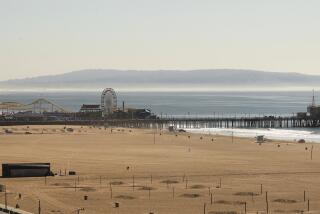U.S. OLYMPIC FESTIVAL : Study Is Planned After Record-Breaking Year
- Share via
MINNEAPOLIS — The U.S. Olympic Festival appears healthy and strong, but organizers aren’t taking chances with future events.
A task force of athletes and officials with the Olympic sports’ national governing bodies is going to study the festival to see where--or if--changes are needed.
“It may be that the way it is now is just fine,” said Robert Helmick, president of the U.S. Olympic Committee.
The 10th Olympic Festival that ended Sunday leaves the impression that little change is necessary. The festival set records for total attendance (502,262) and ticket revenue ($3.41 million). The previous records were 464,423 and $3.052 million, both set in 1987 in North Carolina.
The operations side of this festival--the nuts and bolts that make sure athletes, coaches and media are provided for--ran smoothly.
“They weren’t one notch better, they were at least two,” said Sheila Walker, the USOC’s director of festivals and competitions. “I’ve had six festivals now, and I’ve never known one with so few brush fires to put out in operations.”
Even so, the festival is getting another look.
“Since 1978, the festival has maintained certain premises such as domestic-only athletes and the regional competition,” she said. “Over the years, while the festival has maintained some of those basic premises, the marketplace has changed dramatically.”
Is the purpose of the Olympic Festival still relevant? Is it meeting a need? Is its output worth what the athletes get in return? How does it help the national governing bodies?
Those are the kinds of questions that will be asked by the task force, which is scheduled to meet next month and present a report to the USOC executive committee in October.
Walker said there have been suggestions made about how the festival can compete for athletes and television time.
“The task force will look at them and determine if those things will enhance the festival,” she said. “Will they make the festival more unique or make it look like something else and thereby dilute its impact?”
The Olympic Festival, held in every non-Olympic year, began in 1978 as a way to showcase America’s future Olympians and give them a chance to compete in a multi-sport atmosphere. The premise has worked--the USOC is quick to note that nearly 74% of the athletes who made up the U.S. summer and winter Olympic teams in 1984 and ’88 had competed in festivals.
However, this year’s festival lacked marquee names, particularly in track and field. And finding ways to attract those names will be something the task force will consider.
The big names are important because cities interested in bidding for the festival must first put up $250,000. Then, once they get it, the cities have to spend millions of dollars to put on the show.
The festival’s appeal figures to be tested next year when it is held in Los Angeles--the largest city yet to serve as host.
“We would like to see more (marquee names),” Walker said. “But I don’t think we have abandoned the idea that this is an elite development tool. Some more marquee athletes would enhance the TV (appeal) of the festival. Right now we are breaking even. We would like to do a little bit better, and that might help us.”
Jack Kelly, president of the Twin Cities Festival Organizing Committee, said attracting bigger names would not necessarily mean bigger crowds.
“I’m not disappointed in the quality of the athletes,” Kelly said.
Walker used Mary Lou Retton as an example of a little-known athlete at the festival becoming an Olympic star. Retton was at the 1981 festival and won a bronze medal in the vault.
“She was not a marquee name,” Walker said. “Had a more marquee athlete been there, maybe Mary Lou wouldn’t have.”
More to Read
Go beyond the scoreboard
Get the latest on L.A.'s teams in the daily Sports Report newsletter.
You may occasionally receive promotional content from the Los Angeles Times.






